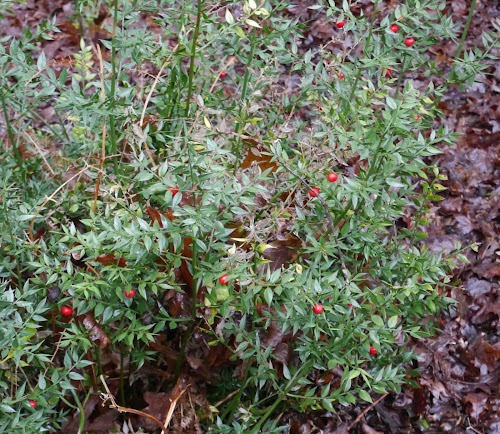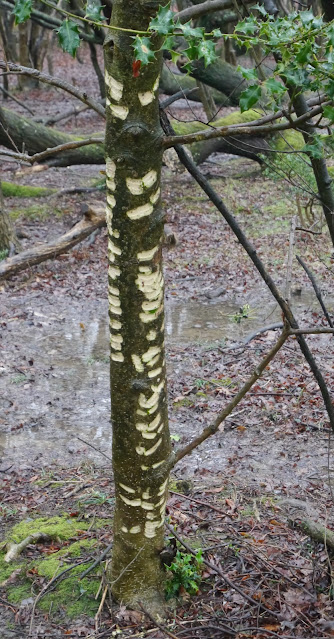Walk report: 23 March 2023 Linford Botton with Jo Dowle
Although the forecast for the day was for occasional heavy showers an intrepid group of 11 set off from the car park, having first proved the old adage that the best birds are often found in the car park. We had close views of a singing Chiffchaff in a Sallow and heard another one answering from trees near the stream. Another was singing from a similar tree 100 yards into the walk and was still there when we returned along the same route a couple of hours later. These tiny birds may have wintered locally or perhaps have recently returned from wintering in southern Europe and North Africa. Other birds seen and heard at the start were Chaffinches, Goldcrest and Blue and Long-tailed Tits.
 |
Singing Chiffchaff © Richard Smith |
Linford Bottom holds a beautiful stream, but was running so high that the surrounding area was very water-logged and muddy, so we headed into the enclosure and followed a cycle track to the north. Along the route we heard two singing Mistle Thrushes, one perched high up on a pine tree despite the wind and living up to its old name of the Stormcock. The track emerges back into the valley bottom where there is a beautiful grassy area covered with old ant mounds covered in mosses and other small plants. Here we noticed a clump of Lesser Celandine not yet in flower. We also had good views of a Red Kite soaring above us, easily riding the strong wind.
 |
Mistle Thrush © Richard Smith |
 |
Wild Daffodil © Richard Smith |
 |
| Our route © Crown copyright 2023 Ordnance Survey. Media 006/23. The licence is valid until 31 December 2023 |
Walk report from Wootton Bridge, 9th March 2023 with Derek and Lorraine Carter
Despite the wet conditions, a hardy band of folk gathered at Wootton Bridge car park, before heading over the Avon Water to enter Broadley Inclosure. There Wood Spurge and Foxgloves were starting to show, along with several ferns such as Hard and Hart's-tongue. We went deeper into the woodland, past many areas where wild dens had been made amongst the fallen leaves, presumably by children, before diverting down to open grassland by the Avon Water, which was flowing strongly. Here we were lucky to see Siskins, a Grey Wagtail and Song Thrush, along with the ever-present Robins and Blackbirds. A Green Woodpecker yaffled happily, but I don't think was seen.
 |
| Butcher's Broom © Chris Robinson |
Returning to the original route more Siskins showed themselves and then the fungus Ergot was spotted at the side of the path. We left the Inclosure onto the open grass and heath area up towards Wootton, noting generally the progress of spring, for example on the opening buds and catkins of Willow and Hazel, but the cold and rain kept overt insect life out of view.
 |
| Damage to Holly © Chris Robinson |
We puddle-hopped back towards the road, where three members of the group went directly back to the start, the rest of us crossing the road, past the first of many examples seen of Butcher's Broom, still showing it's berries, into the path that skirts the Wooton Coppice and Brownhill Inclosures. Open pastures on our left lacked the bird life that would probably have been there in better weather. We carried on past areas of beautiful, heavily mossed trees and banks, before turning right towards the last bit of our journey. Overhead, Buzzards were seen, then the eagle-eyed amongst us spotted that both Hazel and Larch were showing their tiny red flowers.
 |
Larch © Richard Smith |
Frog spawn was quite plentiful in the shallow ditches alongside path, a lot of it partly obscured by the rusty-brown silt surrounding it, but some of the last clumps had progressed into the early tadpole stages. Finally we found some lonely, small daffodils, but the hope that they might be of the native variety was short-lived, for they were probably just a small cultivated variety, such as Tête-à-tête, that had somehow made their way into the wild – we wonder what story lays behind that? D&LC

Our route
© Crown copyright 2023 Ordnance Survey. Media 006/23.
The licence is valid until 31 December 2023
Walk report: 06 March Keyhaven with Chris Robinson
The last ‘Birding’ walk of 2022/23 winter season was well attended
despite the weather living up to the winter billing – it was cold! The tide was
high.
A good day for raptors, though few really close sightings. Kestrel, Buzzard, Marsh Harrier, Red Kite and Peregrine all put in an appearance.
Marsh Harrier © Chris Robinson
There were good numbers of Brent Geese, for once outnumbering Canada Geese. There were plenty of ducks, though fewer than of late. Maybe they are off on their travels. Gadwall were noticeable, have their numbers increased this year? A pair of Shelducks were on the first pool (before Keyhaven Lagoon). They have bred there in the past so this pair maybe setting up a territory.
 |
| Shelduck © Chris Robinson |
Waders were generally sparse, only one Ringed Plover and one Ruff spotted. Curlew were around in ones and twos all the way round the sea wall. The Black-tailed Godwits were in several flocks of 20-30 birds (Avon Water, Fishtail). Dunlin and Turnstones seemed fewer than of late but that may be because of the tide. Lapwings were displaying all the way round the walk, as were Redshanks.
Black-tailed Godwits © Chris Robinson
The Spoonbill count was 9, including juveniles. There was a ‘raft’ of Great-crested Grebes on the sea near the Point.
 |
| Spoonbill - immature © Chris Robinson |
Small birds were scarce. Meadow and Rock pipits, one Reed bunting and a Goldcrest were seen, along with Skylarks (some singing). CR





